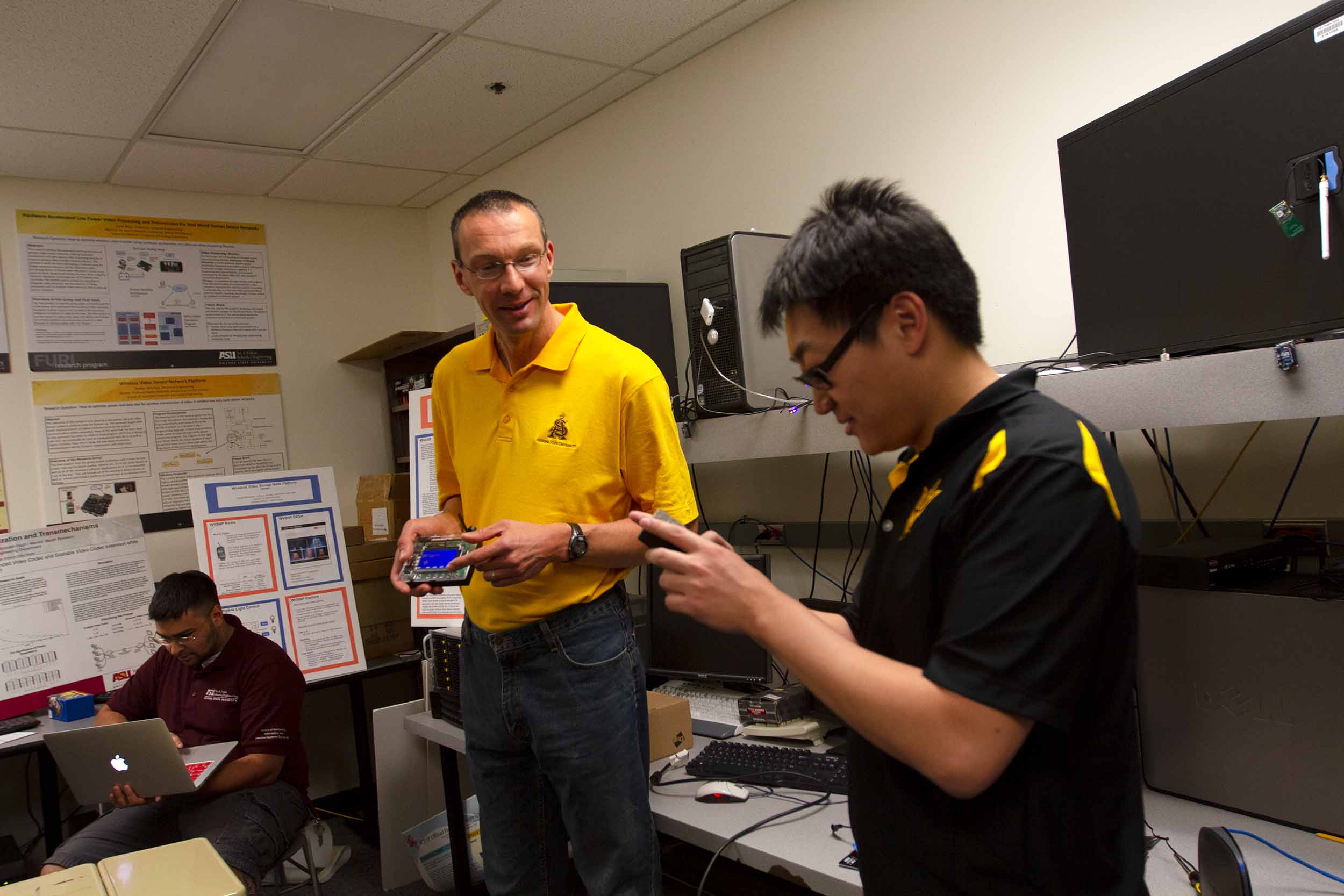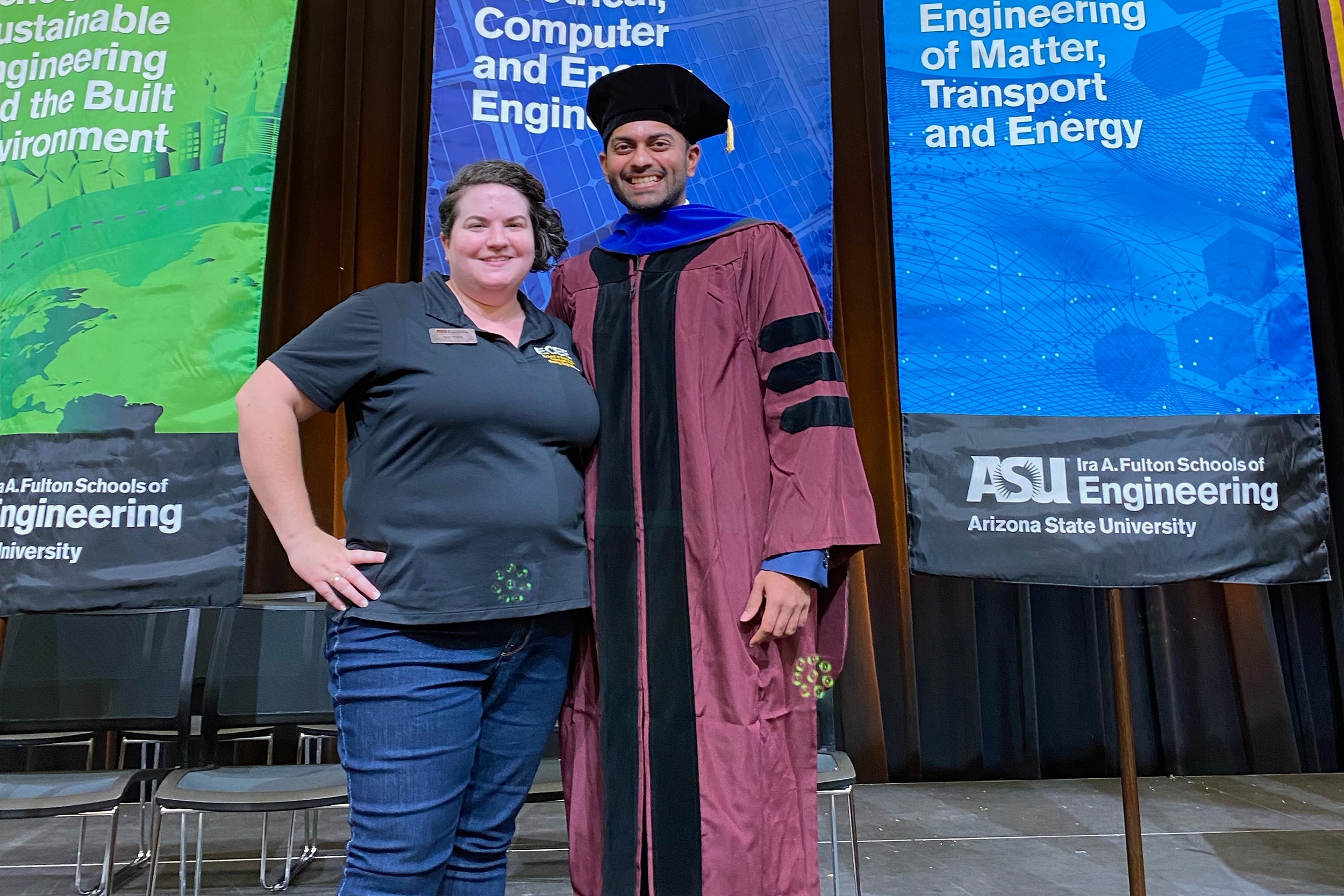
Accelerating data supply | ASU Information
Table of Contents
Every single portion of a 2nd counts when transmitting data for time-sensitive operations these kinds of as assembly lines or autonomous automobiles. That portion of a 2nd can make the distinction in steering clear of production malfunctions or even conserving someone’s lifestyle in a self-driving car or truck by dodging a disastrous crash.
The standard system of transmitting data in excess of the online relies on a theory recognised as “best-effort supply,” which usually means that even though the net services will try out its most effective to deliver pieces of knowledge, known as packets, from one particular pc to the upcoming, the community would make no ensures as to how prolonged the approach will get. 

Martin Reisslein (heart), electrical engineering professor and pc engineering graduate method chair, and a former university student, Venkatraman Balasubramanian (not revealed), are conducting investigation to make community-based facts shipping far more successful for applications in which each individual fraction of a second counts. Image by Jessica Hochreiter/ASU
Down load Total Graphic

“Clearly, these a cavalier attitude toward delays is not suited for true-time networked apps,” says Martin Reisslein, a professor of electrical engineering and chair of the graduate computer system engineering software in the Ira A. Fulton Universities of Engineering at Arizona State College.
Laying the groundwork for faster data transmission
Reisslein established out to address this problem with Venkatraman Balasubramanian, now a senior network software engineer at Intel and an electrical engineering college affiliate at ASU. Balasubramanian examined beneath Reisslein as a doctoral college student right before graduating from ASU’s pc engineering system in the summertime of 2022.
The Institute of Electrical and Electronics Engineers formulated expectations regarded as Time-Sensitive Networking for specifically these styles of techniques in which each and every microsecond of time saved when transmitting knowledge is essential. These specifications deliver a framework for how these types of time-sensitive devices require to operate faster than ideal-exertion delivery, but they do not specify the information of how to accomplish it. Reisslein likens the framework to procedures in athletics.
“There are ground rules for a recreation these as basketball,” he claims. “However, the rules do not specify the approach of how to go the ball from player to player throughout the court and when exactly every single player need to throw the ball.”
Balasubramanian took the guide on a investigate paper that he co-wrote with Reisslein that laid out theoretical information of how to attain the swiftest doable info transmission for time-delicate devices. A third collaborator whom Balasubramanian realized from his master’s diploma scientific studies at Canada’s College of Ottawa, Moayad Aloqlaily, consulted on the structural layout of the network system and developed the paper’s graphic illustrations.
The effects of their attempts, “An SDN architecture for time-sensitive industrial IoT,” won a finest paper award from technical journal Laptop or computer Networks.
Developing a knowledge rapidly lane
Reisslein and Balasubramanian’s paper differs from past function in the industry thanks to a critical aspect in the specialized facts.
Reisslein says most theories on the greatest tactics for transmitting knowledge so significantly have targeted on two primary approaches. The first duties by itself with getting the most effective route to shift the knowledge among the points alongside its path, referred to as switches. The second prioritizes scheduling, which establishes when precisely to go the info among switches.
To make clear the course of action, he once more takes advantage of a basketball activity as an analogy.
“One has to be careful when planning the routing and scheduling, as there are other packets that can block an urgent packet,” he says. “Just like dynamically steering clear of blocking by players of the opposing crew, our time-sensitive community scheduling and routing reacts to other packets to safeguard the passage of an urgent packet in a specified time limit, this sort of as one millisecond, across the community.”
Past exploration has also focused on a heuristic, or trial and mistake, technique. In distinction, Reisslein and Balasubramanian’s technique was based mostly on mathematical calculations. This assures improved optimization for the packets’ routing and scheduling. The method included analyzing unique ways to code and optimize computation of the mathematical calculations.
“Eventually, I had to get artistic,” Balasubramanian suggests. “I broke a couple of things in the code, eradicated a whole lot of points from it and optimized the framework for a much better and more evolved architecture.”
Reisslein credits Balasubramanian’s exploration capabilities to ASU’s interdisciplinary laptop engineering doctoral software. The application is managed in conjunction with ASU’s College of Computing and Augmented Intelligence, also a section of the Fulton Faculties, and puts a significant emphasis on investigate and internships. For the duration of his time in the system, Balasubramanian had internships at Nokia Bell Labs, Samsung and Intel, where he additional honed his competencies via hands-on practical experience.
College students in the method are also demanded to get lessons exterior of their main space of emphasis to expand their engineering expertise.
Lynn Pratte, graduate advising manager for the School of Electrical, Pc and Strength Engineering, states the laptop engineering program is considerably simpler to tailor to personal students’ career desires than most universities’ pc engineering plans.
“No two pupils will have the exact same plan of study,” Pratte suggests. “We are graduating college students who have a wonderful foundational know-how of laptop engineering subjects and have selected what they want to specialize in.”
For Balasubramanian, doing work on research with Reisslein was a emphasize of his time in the system.
“The words ‘amazing’ and ‘awesome’ are not ample to explain Dr. Reisslein,” he suggests. “He’s in all probability the real Iron Gentleman who I’ve experienced the prospect to operate with.”

Faculty of Electrical, Laptop or computer and Strength Engineering graduate advising manager Lynn Pratte poses with Venkatraman Balasubramanian at Balasubramanian’s PhD doctoral degree convocation. Photo courtesy of Venkatraman Balasubramanian
Racing in opposition to time in the serious globe
Reisslein suggests the research he and Balasubramanian have executed is a very important stage toward advancing time-sensitive community know-how, these types of as guaranteeing that production robots functionality correctly. The know-how can also be employed to give smoother operation when connecting numerous impression-detecting LIDAR sensors with each other with the steering logic in an autonomous auto and optimally managing autonomous car or truck programs this kind of as brakes and steering.
Balasubramanian also sees long run implementation of the analysis in producing world-wide-web-primarily based laptop purposes quicker.
“Optimal resource allocation is likely to make every thing quicker,” he states. “Whether it is accessing Netflix to check out your beloved demonstrate, uploading issues on Instagram or just vlogging on YouTube, network resources have to be utilised in a quite strategic manner at the community operator amount.”
Reisslein sees the exploration as a developing block for basic shifts in wi-fi communications technology. He is performing on integrating time-delicate community technology into chip designs for subsequent-generation 5G and, hunting towards the long term, for 6G mobile networks.
5G systems, according to Reisslein, set better emphasis on making use of computer software to run a variety of systems. Past models have relied on specialised chips for different features, whilst emphasizing software will allow basic-purpose computer systems to run these specialized duties.
This necessitates much more economical information input and output capabilities for world wide web-linked basic-purpose computer systems, which would allow them to tackle far more complex courses that use a good deal of data from the world-wide-web.
To get to 6G methods, Reisslein anticipates that this line of analysis on accelerating info delivery requires to be merged with novel communications investigation that moves beyond mathematician and laptop or computer scientist Claude Shannon’s communication idea. Shannon’s idea, which has dominated electronic communications because the 1950s, focuses on moving details involving two points, no matter of regardless of whether the receiver can comprehend its indicating.
This involves transferring substantial portions of facts. Approaches going past Shannon’s theories focus on semantic this means, or guaranteeing the receiver understands what is sent, somewhat than sending each and every past little bit of information and facts.
“This can reduce the amount of bits that actually have to have to be transmitted over the network on an exponential scale,” Reisslein claims. “Thus, for a supplied network ability, we can, for instance, possibly handle an exponentially more substantial number of robots with the exact community.”
